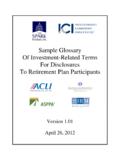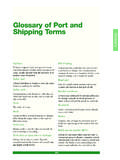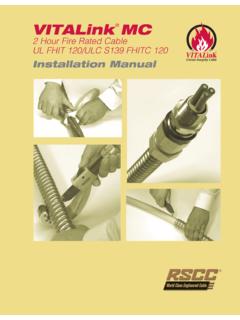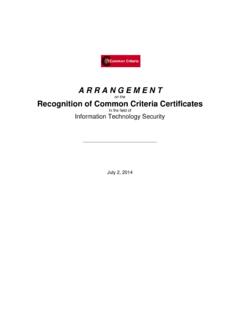Transcription of Decentralized Wastewater Glossary - Onsite Consortium
1 Decentralized Wastewater Glossary Compiled by The Consortium of Institutes for Decentralized Wastewater Treatment 2007 CIDWT Glossary 2007 iCIDWT Decentralized Wastewater Glossary 2007 Introduction The definitions provided in this Glossary were specifically chosen for their usefulness to professionals in the field of Decentralized Wastewater treatment. The philosophy behind the document is that in order for Decentralized Wastewater treatment to remain a permanent component of our water treatment infrastructure, we in the industry must define the associated and all-encompassing management requirements for sustainable long term performance. This document provides the foundation for doing so. The writers consulted many existing glossaries and acknowledge the considerable value of those sources. The final definitions were chosen on the basis of the best fit to the industry as a whole as determined by a wide group of stakeholders and the result is a collection of terms that illustrates the broad landscape of Decentralized Wastewater treatment.
2 In addition to definitions, see , see also and also known as references are included. A see reference directs the reader to either the preferred term (as identified during the review process) or to the appropriate alphabetical location based upon the core term. For example, active aeration is defined under aeration, active . A see also reference directs the reader to terms that are closely related and provides a broader perspective or supplemental information. An also known as reference indicates that the terms are used synonymously. The authors intentionally chose preferred definitions based upon a positive connotation. References to the diagrams are also included where appropriate. The authors believe that this Glossary will move the field of Decentralized Wastewater treatment forward in a positive, proactive manner. This terminology will undoubtedly evolve over time as professionals use and refine the language. CIDWT acknowledges the tremendous contribution of reviewers, both individual and organizational, who have invested time and effort over the course of this project.
3 The group also acknowledges the financial support of the US Environmental Protection Agency through the Water Environment Research Foundation. CIDWT Glossary Writing Team December 2007 CIDWT Glossary 2007 iiCIDWT Glossary Writing Team: Bruce J. Lesikar, PhD, PE Texas Cooperative Extension Nancy Deal, MS, REHS, North Carolina State University John Buchanan, PhD, PE University of Tennessee Kitt Farrell-Poe, PhD University of Arizona Dave Gustafson, PE University of Minnesota David Kalen, MS University of Rhode Island David Lindbo, PhD, LSS North Carolina State University George Loomis, MS University of Rhode Island Randall Miles, PhD University of Missouri Graphic and Editorial Assistance by: Justin K. Mechell Texas Cooperative Extension Nicholas Kaechler Texas Cooperative Extension Melinda White NC State University Organizational reviewers: American Society of Civil Engineers National Association of Wastewater Transporters National Environmental Health Association National Onsite Wastewater Recycling Association National Precast Concrete Association State Onsite Regulators Alliance Soil Science Society of America Water Environment Federation Washington On-site Sewage Association CIDWT Glossary 2007 iiiIndividual Reviewers: James Anderson University of Minnesota Gene Bassett Bassett Construction, Inc.
4 Allison Blodig Biomicrobics, Inc. Gary Buttermore Nebraska Department of Environmental Quality Matt Byers Zoeller Co. Inc. Paul Chase State Onsite Regulators Alliance Edward J. Corriveau Penna. Department of Environmental Protection Victor D'Amato ARCADIS, Inc. Kenneth R. Davis Coastal Plains Environmental Group Stephen Dix Septic Solutions, LLC Tom Ferrero National Association of Wastewater Transporters Mark Hooks Florida Dept. of Health Janet Hygnstrom University of Nebraska Terrell Jones NC DENR Onsite Wastewater Section Daniel Larubio Southern Nevada Health District Robert E. Lee Loudoun County (VA) Health Department Robert B. Mayer American Manufacturing John McCray Colorado School of Mines Del Mokma Michigan State University Janet Murray Missouri Small Flows Organization Brent Parker Iowa Department of Natural Resources Christl Pokorney National Environmental Health Association Morgan Powell Kansas State Univ. Research and Extension Barbara Rich Deschutes Co.
5 (OR) Environmental Health Division Dennis Sievers University of Missouri CIDWT Glossary 2007 ivIndividual Reviewers (continued): Tony Smithson Lake County (IL) Environmental Health Shanin Speas-Frost Florida Dept. of Environmental Protection Bill Stuth, Sr. Aqua Test, Inc. Theo B. Terry, III Ring Industrial Group John Thomas Washington On-site Sewage Association Jerry Tyler University of Wisconsin (Retired) Dan Wellington City of Bangor, ME David Wilson David R. Wilson, Citation CIDWT Decentralized Wastewater Glossary . Available online at: (date verified). CIDWT Glossary 2007 vTable of Contents Page Contents 1 Decentralized Wastewater Glossary 103 References Appendices 105 Appendix A: Types of Soil Treatment Areas 106 Appendix B: Reference Tables 107 1. Conversion Factors 108 2. Friction Losses for Schedule 40 PVC Pipe 109 3. Friction Loss Equivalent in Pipe Length (feet) 110 4. Pipeline Volumes for Rigid an Flexible PVC Pipe 111 5.
6 Orifice Flow for Low-Pressure Distribution Applications 112 6. Orifice Flow for Pressure-Dosed Gravity Manifold Applications 113 7. Required Flow Rate to Achieve Two feet per Second Velocity CIDWT Glossary 2007 viList of Figures and Tables Page Figure or Table 1 Absorption area of an above-grade soil treatment area on a level site 2 Absorption area of an above-grade soil treatment area on a sloping site 5 Soil treatment area with areal fill trenches (shown in section view) 6 Soil treatment areas with at-grade trenches (shown in section views) 9 Cross-section of an excavation 15 Clear zone of a two-compartment septic tank 17 Free water surface constructed wetland system 17 Submerged flow constructed wetland system 20 Discharge assembly showing associated components 21 Drip distribution treatment train (typical) 22 Trenches with gravity parallel distribution using a distribution box 22 Below-grade soil treatment area using trenches with low-pressure distribution 23 Trenches with pressure-dosed gravity parallel distribution 23 Trenches with gravity sequential distribution 23 Trenches with gravity serial distribution 25 Interceptor drain installed upslope of a soil treatment area 26 Perimeter drain (section and plan view) around a septic tank and soil treatment area 28 Drop box 30 Evapotranspiration (ET) bed 31 Evapotranspiration/absorption (ETA) bed 35 Graphic representation of daily flow, average daily flow and surge flow 42 Invert of a pipe 44 Landscape position 44 Landscape position descriptors (landscape features) 47 Contour loading rate for trenches 51 Mound soil treatment areas showing gravel trenches in cross section.
7 52 Modified mound soil treatment areas showing gravel trenches in cross section 57 Peak enable operating parameter in a timed-dosing configuration 58 Typical pH of selected liquids 59 Piggyback plug assembly CIDWT Glossary 2007 vii List of Figures and Tables (continued) Page Figure or Table 63 Pump installed within a pump basin 64 Pump installed within a pump vault 66 Redundant off operating parameter in a three-float timed dosing configuration 69 Rotating biological contactor (RBC) 69 Illustrations of runs in various drip distribution configurations 72 Suspended-growth processes within a sequencing batch reactor (SBR) 73 Shallow narrow pressurized trench using 12-inch PVC half pipe 75 Slope shape descriptors 77 Types of soil structure with possible size classes and grades 77 Diagram of types of soil structure 78 Size class descriptors and criteria for various types of soil structure 78 USDA Soil Textural Triangle 80 Spray dispersal soil treatment area and typical associated components 81 Stepdown (section view) 85 Timer enable operating parameter.
8 Three-float configuration with redundant off and a two-float configuration using a single differential switch 89 Soil treatment areas with shallow trenches 93 Globe valve 95 Alarm activation volume, reserve volume, dose volume, minimum volume and operating volume within a demand-dosing tank 96 Average daily volume, surge volume, minimum volume, operating volume and reserve volume within a flow equalization tank 97 Graphic illustration of surge volume compared to average daily flow CIDWT Glossary 2007 1A B C D E F G H I J K L M N O P Q R S T U V W X Y Z A Abandonment: discontinued use of a system component or components by removing them or rendering them inaccessible and inoperable. Above-grade: soil treatment area designed and installed such that all or part of the infiltrative surface is located at or above original ground elevation using appropriate imported material; a final cover of suitable soil stabilizes the completed installation and supports vegetative growth; includes mounds, areal fill and at-grade; see also at-grade and below-grade.
9 Absorption: process of incorporation or assimilation by which one substance is physically taken into and included with another substance; for example, bacteria assimilating nutrients from effluent Absorption area: design parameter described by the square footage of an absorptive surface that is associated with the hydraulic acceptance of effluent; see also absorptive surface; basal area; and infiltrative surface. Absorption area of an above-grade soil treatment area on a level site CIDWT Glossary 2007 2 Absorption area of an above-grade soil treatment area on a sloping site Absorptive surface: plane of native soil where hydraulic properties change. Acceptable: condition in which a component is performing its intended purpose and is considered to be in an operable state. Acceptance rate: infiltration of effluent into a designated media expressed as a rate ( , cm/day); see also long-term acceptance rate. Access riser: see riser, access. Accepted engineering practices: those requirements which are compatible with standards of practice required by a registered professional engineer.
10 Activated sludge: highly concentrated mass of live organisms in a suspended-growth aerated and mixed environment. Activated-sludge process: Wastewater treatment process that uses activated sludge to biologically convert non-settleable (suspended, dissolved, and colloidal) organic materials to a settleable product using aerobic and facultative microorganisms; typically followed by clarification and sludge return. Active aeration: see aeration, active. CIDWT Glossary 2007 3 Additive: product added to a sewage treatment system marketed to improve performance. Adsorption: adhesion of a substance to the surface of solid bodies or liquids with which it is in contact. Aeration, active: introduction of air via either mechanical means or diffused aeration; see also aeration, passive. Aeration, diffused: process of introducing air bubbles under pressure into a treatment unit using a compressor or blower and a diffuser. Aeration, mechanical: process of introducing air into a treatment component by physical agitation using a device such as a paddle, paddle wheel, spray nozzle or turbine.






